 K.J Choi has a plan for continually getting better, do you? K.J Choi has a plan for continually getting better, do you? Do you have a structure or framework for getting to a low score average so you can qualify to play on a professional golf tour? Do you have some sort of plan or defined purpose for achieving your golf swing goals? Or do you just take it as it comes and do what feels right at the time? Possibly you might be a golfer that does a bit of both, a little bit plan and a little bit of take it as it comes. How about timelines? Do you have an idea of when you want to go to a qualifying school and what needs to be improved before you get there? Whichever way you look at it, I’m sure that you would agree that advanced golfers will perform better when they have a definitive idea of how, where and when they plan to achieve their goal of being ready for qualifying school? But can we be confident enough to believe that we can achieve our plan when we want to? Yes we can plan to achieve a certain goal by date x, but we always need to take into account the many variables that might get in the way of being able to achieve our swing change goal by a particular time.  Justin Rose and his coach Sean Foley have a plan for improvement. Do you? Justin Rose and his coach Sean Foley have a plan for improvement. Do you? Here’s a question for you to answer. Imagine it's January and let’s say that you were going to go to Asian tour qualifying school in 12 months’ time. Right now your score average in competition is 74 and you have just started taking a series of golf lessons with a reputable swing coach to improve an aspect of your full swing technique. The reason you're doing this is because you believe that it will help you to get your score average down to 71 so you can go to Q School with confidence. At face value this seems like a reasonable approach to getting to your goal and is a relatively common approach for getting ready for a tour school. The trouble is that it’s reasonable – just not ideal. Simply put, there are a number of questions to consider when lowering your score average by three strokes in 12 months, like why you would be leaving it so late to make such a drastic attempt to lower your score average? This raises another question, like why you have decided that a swing change/improvement will be your primary strategy for lowering your score average by three. Depending on the complexity of your swing change, you need to assess the level of change and determine a timeline for achieving it. Is it possible to improve your golf swing and lower your golf score by three within 12 months? I'm sure it has been done before, but in our experience it is not likely to happen within this timeline. Golf Scores Are Erratic Golf scores fluctuate from day to day in erratic patterns. There is nothing consistent about them and trying to lower your score average by focusing on making a swing change within a compressed time period can be a disaster waiting to happen. Have a look at one of the best golfers in the world Adam Scott and take note of the erratic nature of his golf scores over a season on the PGA Tour. Adam's score average (actual) was 70.25 in which ranked him 15th on tour and as good as he is notice the high scores throughout the season and how he balances this with low scores which is how we arrive at his score average. Adam's first score of the season on the tour was a 71 at the Northern Trust Open and his last score of 69 was in the Tour Championship. From the 58 competitive rounds within these rounds on the PGA Tour he was able to reduce his actual score average by .75. Now Adam is not making any major swing changes to be able to accomplish this result, he's simply working on the weakest skills that he can manage whilst travelling around the US on tour. If you are considering going to tour qualifying school in 12 months you would have to make sure that the change you were making to your technique was very minor so that it doesn't affect your ability to score. This rarely happens, especially with compressed timelines. Time Compression Increases Pressure When you compress time you increase pressure, and a swing change whether minor or major requires more respect than that. How long does it take to learn and change a swing habit? It depends on how you learn it, but it requires the amount of time it takes for you to learn it so you are able to perform it under the pressure of tournament pressure. Tour school is the kind of pressure that brings even the best learned methods undone. The Golf Swing Change Model
How do you manage swing change within a time period? Good question. You will find it helpful to use our swing change model that we developed and use at Pro Tour Golf College to manage swing change. When changing a swing the first question to consider is the level of complexity of the change. What this means is how many individual components make up the change. Do you have one thing to think about and coordinate in your technique or do you have more? In our model the simplest change is just one component which ranks low in complexity on our swing change scale. One squared equals one. Two squared equals four, which is four times more difficult to change as one component is. Three squared equals nine which is nine times more difficult to change as one component. And on it goes... Golf Swing Levels of Change
The level of complexity (amount of components to change), the amount of repetitions (correctly executed), and the quality of the golf instruction will ultimately determine how long your swing change will take. It is always longer than you think and our model is based on advanced and elite golfers making changes to golf swing techniques that are at the autonomous stage or the unconscious competence stage of learning. It is probably easier to work on other areas within your game within the 12 months to help you reduce your score average by three strokes without having to modify your golf stroke. In next weeks article I'll show you how to design a periodized plan for the year to help you to manage swing change and also lower your golf scores so you can give yourself the best shot possible of not only getting to tour school in 12 months, but also qualifying to play for pay. Lawrie Montague and David Milne - Pro Tour Golf College Your Success On Tour is Our Business  Charlie Wi one of the best in proximity to the hole from sand Charlie Wi one of the best in proximity to the hole from sand As you would know if you read our blog on a regular basis we like to look at the statistics of tour golfers and share them with you in a way that makes sense. We want you to understand that golf statistics are very important as you develop as a player and that they will help you to benchmark yourself against accomplished golfers who are playing successfully on a professional golf tour. Recently I was looking at proximity to hole results from the sand for the 2013 PGA Tour season and one golfers results stood out from the rest of the golfers in the top portion of the list. Now this golfer wasn’t ranked number one for the year from sand as that honour went to Justin Rose who for the 62 rounds of golf he played he managed to hit 59 of his sand shots within 6 feet and 10 inches (2.08 metres) from the hole on average. This golfer was ranked in the top 10 for 2013 season and hit his sand shots on average only 4 inches further away from the hole (7 feet 2 inches) than Justin did, but here’s the kicker; he achieved this incredible standard from 123 sand shots, which was more than double Justin Rose’s attempts. Charlie Wi is more widely known as an exponent of the “stack and tilt” golf swing method, but few if anyone (apart from his caddy and instructors) probably know how effective he is from the sand. I think you’ll agree that Charlie Wi is extremely successful at getting close to the hole from the bunker? But as you know it’s all well and good being able to hit it relatively close to the hole from the sand, because once you hit it to close range you still have to putt it, and this is where it really matters. Charlie ranked 56th for scrambling from the sand in 2013 with 66 of his 117 bunker shots being converted to par or better which is 56.4 percent.  Matt Kuchar was actually the best in scrambling from the sand in 2013 with 62 saves from 88 attempts, or 72.09 percent. Between Charlie Wi and Matt Kuchar there were about 55 golfers who were able to get the ball up and down out of every possible lie in the bunker better than 56 percent of the time. This is an exceptional standard, but it’s also critical to be this effective if you are going to maintain your score momentum during a round. Putting Effectiveness From Short Range What about putting effectiveness from 7 feet with Justin Rose and Charlie Wi? How good are these guys? I mentioned that Justin Rose’s proximity to the hole from sand was 6 feet 10 inches and that he ranked number one in this category. Well he is also a great putter from short range and his putts made from inside 7 feet in 2013 was 73.47 percent ranking him number three in this important category where he made 36 putts from 49 attempts. Remember that Charlie Wi who was only 4 inches further away from the hole than Justin Rose out of the sand, how did he fare in this category? Not nearly as good, Charlie ranked much higher than Justin at 96th with 58.46 percent of putts made from this distance; he made 38 putts from 65 attempts from inside 7 feet of the hole.  You can see from this simple analysis that it is one thing to hit it relatively close to the hole when you miss a green, but you have to develop your putting skills particularly inside an imaginary 10 feet zone to be competitive on a professional golf tour. The key to understanding where your game is deficient is to look at the relationship of one category to another, like sand proximity to the hole and how many putts you make. Start monitoring your greenside strokes within 30 yards (28 metres) of the edge of the green and when you practice make sure that you practice your greenside wedge skills (chip, pitch, sand, flop and trouble) and that you measure your proximity to the hole results when you putt out. This is so you can understand the critical relationship between how far you are hitting it from the hole and how many putts you take to get it in the hole. At Pro Tour Golf College our students practice their short-game skills using the Par 20 Score Card pictured below. We map out 10 holes around the pitching green with chip, pitch, flop, sand and trouble shots of various distances and when they play their shots to the pin we measure their proximity to the hole using a very simple strategy of counting paces or steps from the pin to their ball.
If you hit it 10 steps from the pin it would be zone 10. I think you get the idea. Using a simple score card like the one we use you can monitor your proximity to the hole easily and effectively. After you practice this way you will start to notice the importance of hitting your shots closer to the hole because you will see the correlation between proximity to the hole and putts made, and this is what it's all about if you want to become a competitive amateur or professional golfer. Take the time to monitor your distance from the hole and work with your golf instructor on improving this critical performance statistic and I guarantee you that with a lot of hard work and focus you will start to see a big difference in your scrambling ability around the green. Lawrie Montague and David Milne - Pro Tour Golf College Your Success On Tour is Our Business We have a limited time special rate for Aussie golfers who want to train with us for our 1st semester in 2014...
|
Archives
June 2019
|
Proudly Supported By
Copyright © 2011 - 2018 Pro Tour Golf College
Website Managed By Golf Performance Media
All Rights Reserved
Website Managed By Golf Performance Media
All Rights Reserved









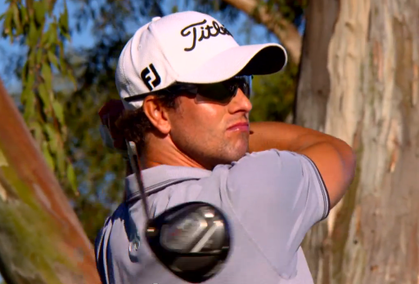





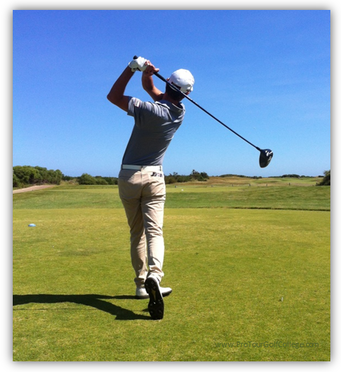


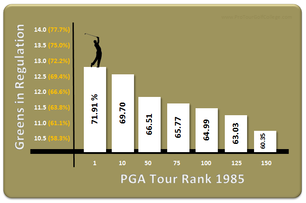


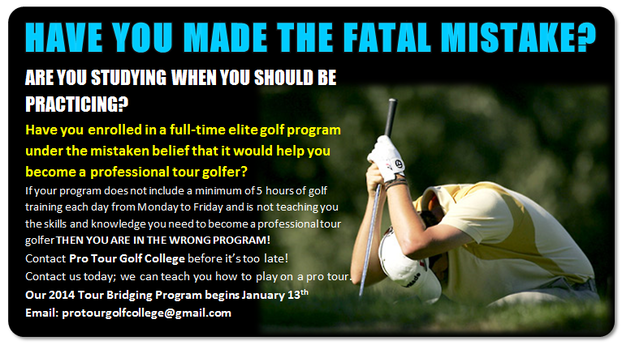



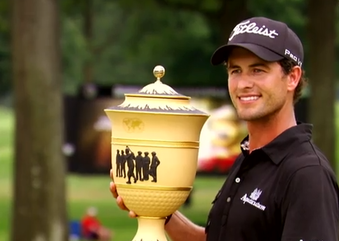

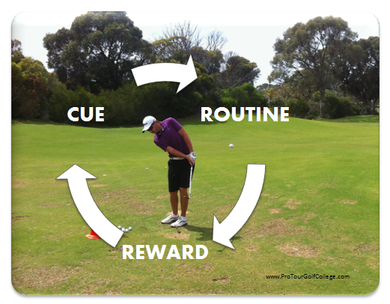









 RSS Feed
RSS Feed



